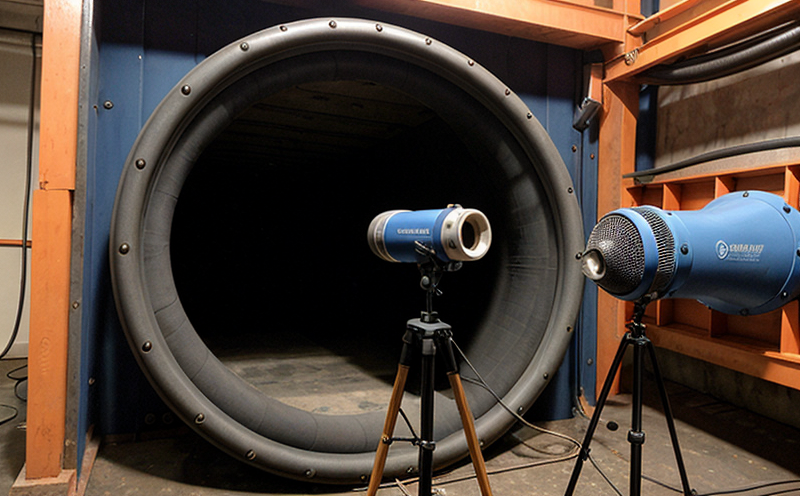Ultrasonic Testing (Non-Destructive Acoustic Methods)
Ultrasonic testing is a non-destructive evaluation method widely used in various industries to inspect materials and components for internal defects. This technique employs high-frequency sound waves that travel through the material being tested. The integrity of the structure or component can be assessed by analyzing how these sound waves interact with the material's surface, interfaces, and any internal flaws.
Ultrasonic testing is particularly useful for detecting small defects such as cracks, voids, porosity, and inclusions that may not be visible to the naked eye. The method works on the principle of wave propagation and reflection; when a defect or anomaly is present, it causes an alteration in the acoustic properties which can be detected by the testing equipment.
The primary advantage of ultrasonic testing lies in its ability to provide real-time imaging of internal structures without compromising the integrity of the material. This makes it ideal for quality assurance and compliance in sectors like aerospace, automotive, and manufacturing where structural integrity is paramount. The technology also allows for rapid assessments that can significantly reduce downtime and ensure continuous production.
For precise defect detection, ultrasonic testing requires a calibrated probe, appropriate coupling fluid, and a suitable frequency range depending on the material properties being tested. The technique typically involves generating and receiving ultrasonic waves through contact or immersion methods. Contact methods use probes that are in direct contact with the surface of the component, while immersion methods involve submerging the component into an aqueous solution.
Ultrasonic testing is governed by several international standards including ISO 17640 and ASTM E2983. These standards provide guidelines for the use of ultrasonic testing equipment, calibration procedures, and interpretation criteria to ensure consistency across different laboratories and industries. Compliance with these standards ensures that the results are reliable and can be trusted in regulatory contexts.
The benefits of using ultrasonic testing extend beyond mere defect detection; it also enhances process control and quality assurance by providing real-time data on material properties and structural integrity. This capability is crucial for industries where safety and performance are critical, such as the aerospace and nuclear sectors. By integrating ultrasonic testing into regular maintenance schedules, organizations can prevent costly failures and ensure that components remain operational throughout their lifecycle.
- Non-destructive evaluation ensures material integrity without compromising functionality.
- Precise defect detection allows for early intervention to prevent catastrophic failure.
- Real-time imaging provides actionable insights into structural health and performance.
- Compliance with international standards enhances credibility in regulatory environments.
Applied Standards
The application of ultrasonic testing is governed by a variety of international standards designed to ensure consistency and accuracy. Key standards include ISO 17640, which provides general requirements for ultrasonic testing equipment and procedures, and ASTM E2983, which specifies the use of phased-array techniques in non-destructive evaluation.
These standards outline specific parameters such as frequency range, coupling fluid selection, probe types, and test conditions. They also provide guidelines on how to interpret the results obtained from ultrasonic testing, ensuring that all stakeholders can understand and apply the findings correctly. Compliance with these standards is crucial for maintaining high-quality standards in manufacturing processes and for meeting regulatory requirements.
For example, ISO 17640 emphasizes the importance of probe calibration and the use of appropriate coupling agents to achieve accurate results. ASTM E2983 focuses on phased-array technology, which allows for more detailed imaging by using multiple ultrasonic beams simultaneously. This advanced technique provides enhanced resolution and sensitivity, making it particularly useful in detecting small defects or flaws.
The application of these standards ensures that the testing process is standardized across different laboratories and industries. This uniformity not only enhances reliability but also facilitates communication between manufacturers, inspectors, and regulatory bodies. By adhering to internationally recognized standards, organizations can ensure that their ultrasonic testing practices are up-to-date with best practices and industry trends.
Benefits
- Precise defect detection without altering the component's structural integrity.
- Real-time imaging of internal structures for enhanced quality control.
- Avoidance of costly repairs and replacements through early intervention.
- Compliance with international standards for regulatory and compliance purposes.
Customer Impact and Satisfaction
The implementation of ultrasonic testing has a significant positive impact on customer satisfaction by ensuring the highest quality and reliability in products. By detecting defects early, manufacturers can prevent costly failures and extend the operational life of components. This not only enhances product performance but also builds trust with customers who appreciate the commitment to excellence.
Customers benefit from reduced maintenance costs due to proactive identification of potential issues. The use of ultrasonic testing in quality assurance processes ensures that products meet stringent specifications, thereby meeting or exceeding customer expectations. For instance, aerospace companies rely on ultrasonic testing to ensure the safety and reliability of aircraft components, which is critical for aviation authorities.
The results from ultrasonic testing are often used as a benchmark for product performance in competitive markets. Companies that invest in advanced non-destructive evaluation techniques like ultrasonic testing gain a competitive edge by producing superior products that stand out in the marketplace. This not only enhances brand reputation but also fosters long-term customer relationships.
Furthermore, compliance with international standards such as ISO 17640 and ASTM E2983 adds credibility to the inspection process. This is particularly important for industries subject to strict regulatory requirements, where proof of adherence to best practices can be a deciding factor in business success. By demonstrating a commitment to high-quality testing methods, organizations can build stronger relationships with their customers and stakeholders.





